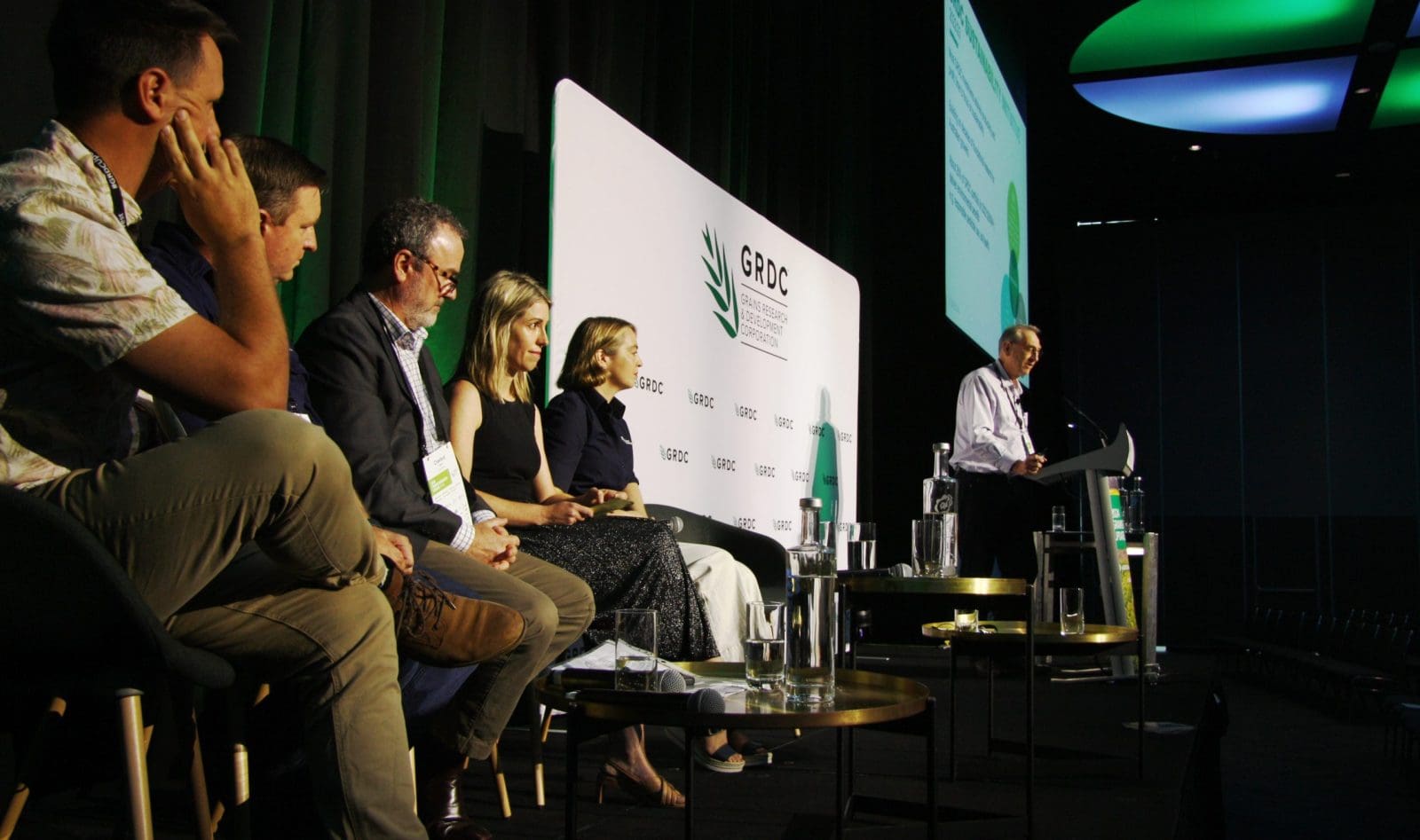
GRDC manager soils and nutrition south Stephen Loss introduces the sustainability focus session at last week’s GRDC Update in Perth. The panel comprised Latham grower Dylan Hirsch, Kondinin Group’s Ben White, Rabobank’s Crawford Taylor, CBH’s Jane Wardle, and BoM’s Stephanie Dickson.
EXPORT customers are expected to up their call for grain with sustainability credentials as self-imposed targets to lower emissions by 2030 near.
Speaking at the Grains Research and Development Corporation’s Update in Perth last week in a focus session on sustainability, CBH sustainability lead Jane Wardle and Rabobank’s Crawford Taylor both said offshore businesses were increasingly looking to lower emissions in their supply chains.
“We’ve got six harvests to go before a lot of these customers have to meet their Scope 3 emissions reduction targets…and we will see a flurry of action,” Ms Wardle said.
Mr Crawford said while governments around the world were driving change, so were companies, and the influence should not be underestimated in agricultural supply chains.
“Of the 100 largest economics in the world, 69 are companies,” Mr Taylor, Rabobank’s head of sustainable business development, said.
“Top companies in the world are actually driving the agenda.
“They have significant power, and they are driving it through the supply chain.”
Wheat interest grows
Ms Wardle joined CBH’s trading and marketing team to help the co-operative, which represents 3500 Western Australian growers, move beyond ISCC certification that provides access to the all-important European canola market.
“We’ve got about 200 customers in 30 different countries; we ran a survey last year and 76pc of them said they’d be interested in partnering with CBH in sustainability (and) 41pc said they would like to partner with carbon-neutral grain.”
Ms Wardle said customers were also looking for not organic but chemical residue-free grain, and traceability, with on-farm carbon emissions being “pretty low” on the list of priorities.
She said while European canola crushers and the global malting industry have driven initial interest in carbon-neutral grain, inquiry was now coming from a much broader base, with wheat now in the picture too.
Ms Wardle said South Korean flour millers looking to meet ESG requirements opened inquiry on wheat, and questions are also coming from millers in Japan and Indonesia.
“All of a sudden, wheat just took over.”
“Indonesia represents a big market for Western Australian wheat, and they’ve been asking us about this in quite a lot of detail.”
“Certainly, the Indonesians and the Japanese are asking a lot of questions about this but extracting actual value from wheat as a commodity is a bit more difficult.
“I think there’ll be big changes coming in that area in the next couple of years.”
Ms Wardle said inquiry on carbon credentials for grain generally was also being fielded by CBH from company’s including China’s COFCO.
“It’s not so much your traditional multinationals with customer-facing products.”
“We need to be part of their story.”
“We’ve been starting to look at how we might link the grower (and) measure their emissions right through to the customer.”
Premium hard to find
CBH last year became Australia’s first grain marketer to achieve carbon-neutral certification for 10,000t of barley.
In a previous session at last week’s GRDC Update in Perth, Ms Wardle said the project delivered knowledge of grower and customer attitudes and insights into the carbon life-cycle through the grain supply chain.
One was that growers delivering it to a designated rather than their closest CBH site added to emissions, a factor which highlights the difficulty in getting value for carbon-neutral grain within a broader supply chain.
“A lot of our customers aren’t in a position to pay for it.
“We’re in this…difficult spot where were trying to get value for a traded commodity through the export supply chain when there’s all these other things affecting food security.”
Those include geopolitical influences to trade flows.
“We’ve got disruptions left, right and centre that are really affecting the price of grain.”
“We’re also at a tipping point where the expectation is that customers start to meet their targets.
“For CBH, we need to create value for our customers, but we also need to create value for our growers.”
“We’re looking at ways we can scale up our supply of carbon-measured grain…and also how we create value from that at the customer level; that will be our focus for the next two years.”
Ms Wardle said she could see a switch for customers from looking at emissions per tonne of grain to the story behind it, namely how the grower or supply chain has lowered emissions.
“If it’s lower each year, that will be in line with their target.”
Grain Central: Get our free news straight to your inbox – Click here

HAVE YOUR SAY